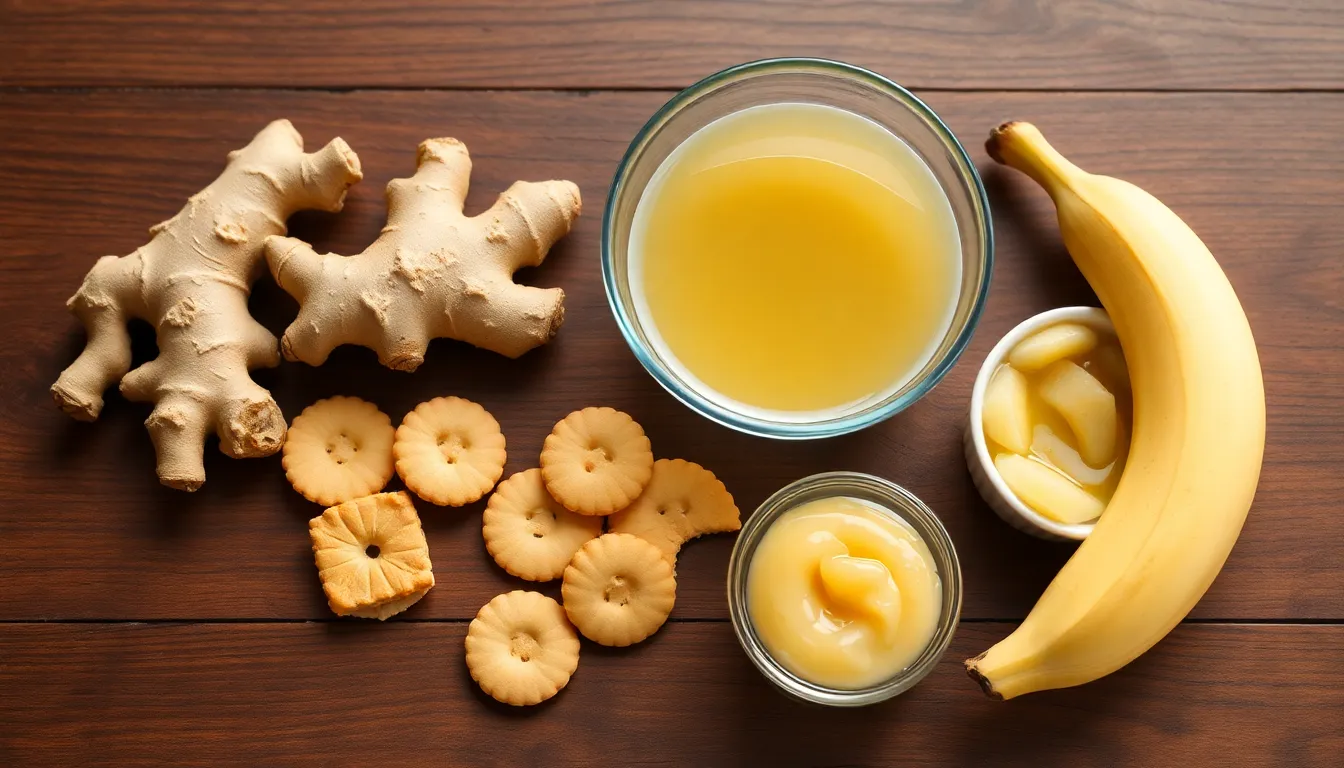Feeling nauseous can be an overwhelming experience that disrupts daily life. Whether it’s due to illness, motion sickness, or even stress, finding relief is essential. One of the simplest ways to ease nausea is through diet. Certain foods can help settle the stomach and provide comfort during these uncomfortable moments.
When nausea strikes, knowing what to eat can make all the difference. Gentle, easily digestible options can soothe the stomach and help restore balance. From classic choices like crackers and toast to soothing herbal teas, the right foods can turn a rough day into a manageable one. Understanding which foods can alleviate nausea is key to regaining control and feeling better fast.
Table of Contents
ToggleUnderstanding Nausea
Nausea involves an unsettling sensation in the stomach, often prompting the urge to vomit. Identifying its causes and symptoms aids in managing discomfort effectively.
Common Causes of Nausea
- Gastrointestinal Disorders: Conditions like gastroenteritis and irritable bowel syndrome can trigger nausea.
- Motion Sickness: Disorientation during movement, whether in vehicles or boats, often results in nausea.
- Medications: Certain medications, especially chemotherapy drugs, can induce feelings of nausea.
- Pregnancy: Hormonal changes during pregnancy frequently cause morning sickness, characterized by nausea.
- Food Intolerance: Reactions to specific foods, such as lactose or gluten, can lead to nausea.
- Infections: Viral or bacterial infections may affect the digestive system, leading to nausea.
Symptoms and Effects
- Stomach Discomfort: Patients often describe a queasy feeling in their stomachs.
- Loss of Appetite: Nausea can significantly decrease the desire to eat.
- Sweating: Increased perspiration, unrelated to temperature or exertion, frequently accompanies nausea.
- Dizziness: Individuals may experience lightheadedness or dizziness, particularly with motion sickness.
- Fatigue: Persistent nausea can lead to feelings of tiredness or weakness.
- Vomiting: In some cases, nausea progresses to vomiting, which may offer temporary relief.
Best Foods to Eat When Nauseous

Certain foods are particularly helpful for easing nausea. These gentle options can provide relief while also being easy on the stomach.
Ginger and Its Benefits
Ginger serves as a well-known remedy for nausea. It contains compounds called gingerols and shogaols, which may promote digestive health. Consuming ginger tea or ginger ale can soothe the stomach, with studies showing ginger’s effectiveness in reducing nausea related to pregnancy and motion sickness. A dose of 1 gram of ginger daily may significantly alleviate nausea symptoms.
Crackers and Toast Alternatives
Crackers and toast are light, bland options that settle the stomach. Specifically, plain saltines or whole grain toast absorb excess stomach acid, minimizing nausea. Other alternatives include rice cakes or plain bagels, which provide simple carbohydrates that are easy to digest without triggering discomfort.
Broth and Clear Soups
Broth and clear soups deliver hydration and nutrients. Chicken broth or vegetable broth supplies electrolytes and aids in replenishing fluids lost during nausea episodes. Clear soups like miso or plain vegetable broth offer nourishment without overwhelming the digestive system. Consuming warm broth can also create a comforting sensation, providing relief from nausea.
Bananas and Applesauce
Bananas and applesauce serve as effective options for nausea relief. Bananas provide potassium, which helps maintain electrolyte balance, especially if vomiting occurs. Applesauce is gentle on the stomach and offers simple sugars for energy. Both are easy to digest, making them ideal during episodes of nausea, particularly for those recovering from gastrointestinal illnesses.
Foods to Avoid When Nauseous
Certain foods can exacerbate nausea, making it crucial to know what to avoid during these uncomfortable moments.
Heavy and Greasy Foods
Heavy and greasy foods often lead to further stomach upset. Fried items, such as french fries and onion rings, increase the likelihood of digestive issues due to their high fat content. Foods rich in oil or butter can trigger inflammation in the stomach lining, worsening nausea symptoms. Foods like bacon, rich sauces, and creamy dishes should also be avoided, as they require extensive digestion, which can intensify feelings of nausea.
Spicy and Strong-Flavored Foods
Spicy and strong-flavored foods can irritate the stomach and digestive tract. Spices like chili powder, cayenne pepper, and black pepper can elicit a burning sensation in the stomach, leading to discomfort and increased nausea. Similarly, potent flavors from foods like garlic and onions can upset sensitive stomachs and provoke an adverse reaction. It’s best to steer clear of curries, hot sauces, and heavily seasoned dishes when experiencing nausea.
Dairy Products
Dairy products may complicate nausea for many individuals. Milk, cheese, and ice cream can be hard to digest, particularly for those with lactose intolerance, leading to increased bloating and gastrointestinal distress. Creamy soups and yogurt also often provoke symptoms and should be avoided. Instead, it’s better to choose lactose-free alternatives when experiencing nausea to minimize discomfort while nourishing the body.
Additional Tips for Managing Nausea
Implementing effective strategies can further help manage nausea. Staying mindful of hydration, meal frequency, and relaxation techniques contributes to overall well-being.
Staying Hydrated
Maintaining hydration is crucial during nausea. Drinking small sips of clear fluids, such as water, herbal tea, or electrolyte solutions, aids in preventing dehydration. Avoiding caffeinated and sugary drinks can further enhance comfort. Sipping fluids consistently, rather than consuming large amounts at once, promotes easier digestion and reduces nausea.
Eating Small, Frequent Meals
Consuming small, frequent meals can help stabilize the stomach. Eating every two to three hours allows the body to process food more easily without overloading the digestive system. Opting for bland, easy-to-digest foods, like rice, toast, or bananas during these meals can minimize discomfort. Avoiding large meals that may trigger nausea promotes better digestion and helps maintain energy levels throughout the day.
Relaxation Techniques
Incorporating relaxation techniques helps manage nausea effectively. Practicing deep breathing exercises, meditation, or gentle yoga can reduce stress and promote a sense of calm. Engaging in these activities regularly encourages relaxation, helping to alleviate nausea symptoms by reducing tension in the body. Additionally, using acupressure on specific pressure points may provide further relief, contributing to a more balanced state.
Finding relief from nausea is essential for regaining comfort and maintaining daily activities. By choosing the right foods and incorporating hydration and relaxation techniques, individuals can effectively manage their symptoms. Gentle options like ginger tea and plain toast can provide much-needed relief while avoiding heavy and spicy foods can prevent further discomfort.
Staying mindful of one’s diet and making small adjustments can significantly impact how nausea is experienced. With the right approach, it’s possible to navigate through nausea and return to a sense of normalcy.


